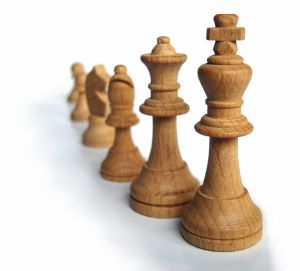 Why is it that beginners fail to choose simple plans that are right before their eyes? One answer may be that beginners do not evaluate the position before choosing a candidate move. Beginners briefly scan the board, choose a move they like and quickly analyze and play this move. The problem with this thought process is that 9 out of 10 times the move they have selected is not the best move, since it is not a move that follows a plan based on the needs of the position. This thought process error occurs during candidate move selection and is a very common mistake that beginner’s must overcome in order to reach the next level. The difference between a weak player and a strong player is that the strong player evaluates the position and they then choose a plan based on this evaluation.
Why is it that beginners fail to choose simple plans that are right before their eyes? One answer may be that beginners do not evaluate the position before choosing a candidate move. Beginners briefly scan the board, choose a move they like and quickly analyze and play this move. The problem with this thought process is that 9 out of 10 times the move they have selected is not the best move, since it is not a move that follows a plan based on the needs of the position. This thought process error occurs during candidate move selection and is a very common mistake that beginner’s must overcome in order to reach the next level. The difference between a weak player and a strong player is that the strong player evaluates the position and they then choose a plan based on this evaluation.
Dan Heisman in a Novice Nook titled ‘Evaulation Criteria’, uses the following criteria to evaluate a position (in order of importance):
1. Material
2. King Safety
3. Activity
4. Pawn Structure
Based on these evaulation criteria, not only will we know which side stands better, but why they stand better and what our plan should be. The candidate moves will show itself based on the plan we have selected.
In order to improve we need to evaluate the position during critical junctures of the game (after the opening is over, after a series of exchanges, whenever the position changes substantially). We should get in the habit of re-evaluating the position every couple of moves to ensure that the needs of the position have not changed. We then need to choose a plan based on the evaluation and select candidate moves that help us meet the goals of our plan. We should then take a close and honest look at our candidate moves and keep looking for the best move that will improve our position on the board.
Hope this helps, and I would love to hear your thought process for evaluating the position and selecting candidate moves.
This is a good topic, and I like Heisman’s criteria, which I steal. His book ‘Elements of positional evaluation’ is a very interesting book-length treatise on the topic with some cool iconoclastic ideas (e.g., that material and space are ‘pseudofactors’, reducible to activity). In theory, I think he is right, but in practice I think he is wrong.
I have a few pages on evaluation in my thought process document, in PDF here.
It starts on page 9. Also, starting on page 4 I describe in some detail my approach to evaluating a position to come up with plans. It discusses in a bit of detail the relationship between plans, candidate moves, and board evaluation.
In particular, I am very happy with the way I found to break down ‘piece activity,’ breaking down the different ways the term is used when discussed by the pros.